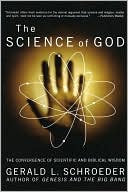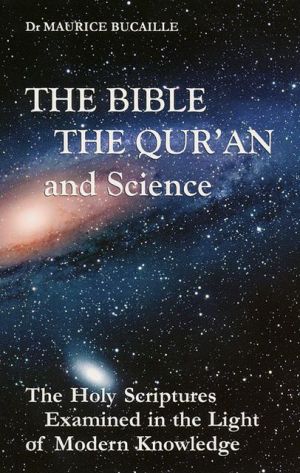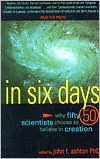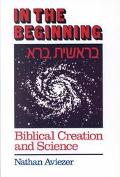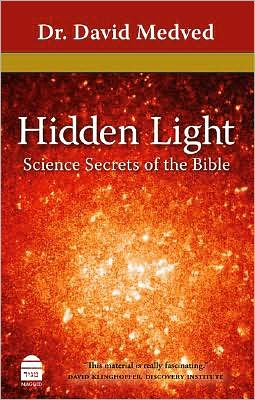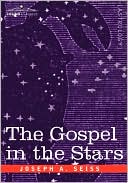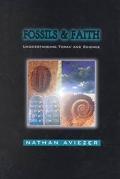Miracles of Exodus: A Scientist's Discovery of the Extraordinary Natural Causes of the Biblical Stories
The Real Story of the Exodus\ Colin Humphreys, a world-renowned Cambridge University scientist, reveals for the first time the concrete, scientific truth behind the Exodus miracles.\ \ The Burning Bush: Caused by a volcanic vent that opened up under the bush.\ Crossing the Red Sea: The water was pushed back by a very strong wind blowing all night. This is a known physical phenomenon called wind setdown. The details given in the Bible mean we can pinpoint where the Red Sea crossing occurred.\...
Search in google:
The Real Story of the ExodusColin Humphreys, a world-renowned Cambridge University scientist, reveals for the first time the concrete, scientific truth behind the Exodus miracles. The Burning Bush: Caused by a volcanic vent that opened up under the bush. Crossing the Red Sea: The water was pushed back by a very strong wind blowing all night. This is a known physical phenomenon called wind setdown. The details given in the Bible mean we can pinpoint where the Red Sea crossing occurred. Drowning Pharaoh's Army: When the very strong wind suddenly stopped blowing, the water rushed back in the form of a rapidly returning "bore" wave, sweeping Pharaoh's army into the sea. Mount Sinai: The real Mount Sinai is in present-day Saudi Arabia, not the Sinai Desert as is generally assumed. Publishers Weekly Reconstructions of biblical events by modern investigators are nothing new, but Humphreys's analysis of the Exodus reflects an unusual combination of homework, legwork and creativity. Humphreys, a materials scientist at Cambridge University, is a self-confessed amateur in the fields of archeology and biblical studies. But he emerges as the best sort of amateur, whose enthusiasm for his subject and joy in puzzle solving have a contagious appeal in spite of occasional quirkiness. As an outsider asking pesky but often astute questions, Humphreys will remind some readers of a certain physicist portrayed in Surely You're Joking, Mr. Feynman!; and like Feynman, Humphreys shows an ability to sidestep scholarly assumptions by checking facts. Humphreys runs numbers, consults disused geological charts and old explorers' memoirs, and investigates sites on foot, unearthing fragmentary but wide-ranging evidence. The book's title is somewhat misleading since Humphreys's goal is to reconstruct the whole Exodus narrative and in particular, to retrace the likeliest route of travel and identify the correct location of Mount Sinai rather than to focus on the miracles themselves. Still, Humphreys rises to a self-imposed challenge to account for the Exodus miracles in terms of natural events (some more feasible than others) that become miraculous in light of their timing and significance for the escaping Hebrews. Although many of his hypotheses have been published before, Humphreys' refinements of detail and especially his comprehensive retracing of the Exodus route will invite curiosity, debate and perhaps some new ways of approaching the Exodus story in historical terms. (Apr.) Forecast: Timed to release shortly before Passover, this walk-through-Exodus detective story is well poised to attract attention. Humphreys has already rated a major article in the Sunday London Times and could also net some big media fish on this side of the pond. Copyright 2003 Reed Business Information.
The Miracles of Exodus\ A Scientist's Discovery of the Extraordinary Natural Causes of the Biblical Stories \ \ By Colin Humphreys \ HarperSanFrancisco\ ISBN: 0060514043 \ \ \ Chapter One\ \ Unlocking the Secrets of the Exodus \ Mount Sinai was covered with smoke, because the Lord descended on it in fire. The smoke billowed up from it like smoke from a furnace, the whole mountain trembled violently, and the sound of the trumpet grew louder and louder. Then Moses spoke and the voice of God answered him. Exodus 19:18, 19\ As I stood in the red light of the rising sun shining on the summit of Mount Sinai in the Sinai Peninsula, I sensed something was wrong. Why was this particular mountain special? Why had Moses led the Israelites about three thousand years ago to this mountain and not to one of the other mountains in the Sinai Peninsula, or even farther afield? To be sure, this mountain was majestic, but so were the other mountains visible from the top of Mount Sinai (see figure 1.1). There appeared to be nothing special about this particular mountain.\ And then I looked down to the dry and truly barren land below. How could two million Israelites, or even twenty thousand with their flocks and herds of animals, have survived for about a year at the desolate foot of Mount Sinai? There was little water and virtually no vegetation, apart from stunted acacia bushes dotted sparsely about. How could they have survived forty years of wandering in this barren wilderness? I knew that the Old Testament described the Israelites as living on quail, but these are migratory birds that pass over the Sinai Peninsula only in spring and autumn. In any case, the Bible texts refer to the Israelites eating quail on only two occasions, each for a few days. How were the Israelites, and their flocks and herds that lived on grass and plants, to survive at other times in the desolate wilderness of the Sinai Peninsula?\ There, in the spring of 1995, standing on the top of the traditional Mount Sinai, also called Jebel Musa, the Mountain of Moses, I resolved to tackle the problem of finding the real Mount Sinai. I knew that many historians and biblical scholars had worked on this problem, but I had an idea for a completely different approach: a more comprehensive study using the understanding of nature provided by modern science. I am a scientist, and as we will see later, looking at the events of the Exodus through the lenses of science does indeed enable us to solve the puzzle of what really happened three thousand years ago. However, the science has to be applied in the context of our knowledge of the ancient Israelites and ancient Egyptians. We will need to understand the history and the geography of the countries involved in the route of the Exodus. We will need to study the main source of information on the Exodus: the Old Testament.\ \ Science and Miracles\ Why might a scientific approach be useful in helping to solve the problems of the Exodus? Science involves the study of the universe, including our planet Earth, using detailed observation, logical thinking, and experiment. Scientists try to understand nature and answer questions like how a lunar eclipse occurs or how metals conduct electricity or how our brain works. The account of the Exodus abounds in extraordinary events reported to have occurred in nature, including a burning bush that wasn't consumed, the ten plagues of Egypt, a pillar of fire and a pillar of cloud in the sky, the Red Sea being forced back so that the Israelites could cross then returning so rapidly that the Egyptian army was drowned, water from a rock, special food called manna, a mountain blazing with fire at its summit, and the River Jordan ceasing to flow, which enabled the Israelites to cross. These events are reported as occurring in our natural world, and some are explicitly stated in the Bible to have had a natural cause. We should therefore expect that present-day science may have an important contribution to make in our understanding of the events of the Exodus. Indeed, as we will see later in this book, I believe there is a natural explanation for all of the events listed above. In many cases this enables us to pinpoint geographically where these events must have occurred, and thus we can reconstruct the extraordinary Exodus journey. As far as I am aware, this is the first time that science (geology, biology, physics, chemistry, and mathematics), in combination with history, geography, archaeology, ancient languages, and the Old Testament text, has been used to reconstruct the route of the Exodus.\ A natural explanation of the events of the Exodus doesn't to my mind make them any less miraculous. As we will see, the ancient Israelites believed that their God worked in, with, and through natural events. What made certain natural events miraculous was their timing: for example, the River Jordan stopped flowing precisely when the Israelites were assembled on its banks and desperate to cross. I will give a detailed natural explanation of this miracle in the next chapter. I believe this natural explanation makes this miracle more, not less, believable.\ \ About This Book\ Like most books, this one is meant to be read from the front to the back. However, if you want to know what happened at the crossing of the Red Sea, for example, then you can go straight to the relevant chapter. I've tried to write this book so that each chapter is reasonably self- contained. I do hope, however, that you won't read only the "highlight" chapters on miracles like the Red Sea crossing. To do so would be to miss fascinating chapters like "The Lost Site of Etham," which doesn't involve miracles at all and is about finding a lost biblical site. It is only if you read the book straight through, from cover to cover, that you can see how the epic events of the Exodus unfold. Only then can you appreciate just how remarkable and amazing the Exodus was ... (Continues...)\ \ \ \ \ Excerpted from The Miracles of Exodus by Colin Humphreys\ Excerpted by permission. All rights reserved. No part of this excerpt may be reproduced or reprinted without permission in writing from the publisher. \ \
Pt. 1Setting the Scene11Unlocking the Secrets of the Exodus32Crossing the River Jordan153The Date of the Exodus28Pt. 2Moses and Midian394Moses and Midian415The Burning Bush616The Mountain of God, the Mountain of Fire82Pt. 3Out of Egypt957Mission Impossible: The Exodus Strategy978How Many People Were in the Exodus?1039The Plagues of Egypt11110Death on the Nile129Pt. 4The Road to the Red Sea15111The Journey Starts: The Pillar of Cloud and the Pillar of Fire15312Where Was the Biblical Red Sea?17213The Red Sea Revealed18814The Lost Site of Etham20615Trapped by Pharaoh22416Crossing the Red Sea244Pt. 5Discovering Mount Sinai26117Turning Bitter Water Sweet26318From the Clue of the Dew to Water from a Rock28219The Spectacular Site of Mount Sinai310Epilogue337Bibliography341Acknowledgments348Index351
\ Robert Gordon"A simply fascinating, and extremely readable, study of the Israelites in Egypt and on the desert way to Sinai."\ \ \ \ \ Reverend; Doctor - John Polkinghorne\ "A strikingly novel interpretation of the Exodus story that will interest many students of the Bible."\ \ \ John Ray"This book will re-open the question of what happened when the Hebrews left Egypt for the Promised Land."\ \ \ \ \ Publishers WeeklyReconstructions of biblical events by modern investigators are nothing new, but Humphreys's analysis of the Exodus reflects an unusual combination of homework, legwork and creativity. Humphreys, a materials scientist at Cambridge University, is a self-confessed amateur in the fields of archeology and biblical studies. But he emerges as the best sort of amateur, whose enthusiasm for his subject and joy in puzzle solving have a contagious appeal in spite of occasional quirkiness. As an outsider asking pesky but often astute questions, Humphreys will remind some readers of a certain physicist portrayed in Surely You're Joking, Mr. Feynman!; and like Feynman, Humphreys shows an ability to sidestep scholarly assumptions by checking facts. Humphreys runs numbers, consults disused geological charts and old explorers' memoirs, and investigates sites on foot, unearthing fragmentary but wide-ranging evidence. The book's title is somewhat misleading since Humphreys's goal is to reconstruct the whole Exodus narrative and in particular, to retrace the likeliest route of travel and identify the correct location of Mount Sinai rather than to focus on the miracles themselves. Still, Humphreys rises to a self-imposed challenge to account for the Exodus miracles in terms of natural events (some more feasible than others) that become miraculous in light of their timing and significance for the escaping Hebrews. Although many of his hypotheses have been published before, Humphreys' refinements of detail and especially his comprehensive retracing of the Exodus route will invite curiosity, debate and perhaps some new ways of approaching the Exodus story in historical terms. (Apr.) Forecast: Timed to release shortly before Passover, this walk-through-Exodus detective story is well poised to attract attention. Humphreys has already rated a major article in the Sunday London Times and could also net some big media fish on this side of the pond. Copyright 2003 Reed Business Information.\ \ \ \ \ Library JournalHumphreys (material science, Cambridge Univ.) has produced a fascinating, highly readable series of scientific explanations for the miracles described in the stories of ancient Israel's exodus and wanderings in the desert. For example, he attributes the stopped flow of water in the Jordan (Joshua 3:15-16) to an earthquake-induced landslide and the burning bush to a volcanic vent opened underneath the bush. He supports his conclusions by consulting with biblical scholars and historical and scientific research. In a central point, that the traditional site identified as Mt. Sinai is wrong, he asserts that accounts of what happened on the mountain point to a volcano but that there is none on the Sinai peninsula. He posits that Mt. Bedr, in Saudi Arabia, is really Mt. Sinai. He concludes that miracles are incidents of extraordinary timing, which can therefore still be called miracles. Though controversial, his work is carefully researched and cogently argued. The subject matter will attract many readers. Recommended for both public and academic libraries.-David Bourquin, California State Univ., San Bernardino Copyright 2003 Reed Business Information.\ \ \ \ \ Kirkus ReviewsManna from heaven? A plague of toads? A Red Sea parted in twain? Miracle, schmiracle. Let science explain. Weird things were afoot back in Egypt land 3,000 years ago: once old Moses got it into his head to lead the people of Israel out of captivity and into the Promised Land, bushes began to burn, rocks to speak, rivers to dry up, and such like. You can read all about it in the book of Exodus, which Cambridge University physicist and biblical hobbyist Humphreys has apparently been doing lo these many years with a literalist’s eye--that of a skeptical scientist, however, not a fundamentalist. If the Bible says that the river Nile ran blood red once God got irritated with an intransigent pharaoh, Humphreys is inclined to take that as, beg pardon, gospel: but, he explains, the river did so because it had filled with dinoflagellates, toxic fish-killing protozoa. The dead fish forced frogs to flee the river, yielding the second of the plagues of Exodus; all those dead critters produced gnats, flies, and dead cattle; the flies brought with them infectious diseases that yielded boils; an exceptionally severe hailstorm brought locusts, which deposited feces on wet stores of grain and killed off the firstborn of Egypt, and just about everyone else, too. Et voilà: the plagues suddenly make sense as a connected natural sequence, just as Mount Sinai turns out to have been a Saudi Arabian volcano, the parting of the Red Sea the result of a particularly sharp offshore breeze. Explaining such phenomena, Humphreys takes a schoolmasterish tone ("Concerning the ability of ancient peoples to go on long walks and marches, I would like to make a short digression to comment on the health and fitness of ancientpopulations because there seems to be a quite widespread belief that three thousand years ago people were riddled with disease and were unfit and unhealthy") that readers will find either pleasantly meandering or maddeningly roundabout--but just about always to the point. Biblical history buffs will likely enjoy Humphreys’s exodian excursions--even if his conclusions do tend to steal some of God’s thunder.\ \

